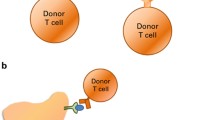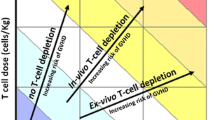Abstract
The graft-versus-leukemia (GVL) effect of HLA-identical allogeneic stem cell transplantation is mainly mediated by alloreactive T-cells directed at the minor histocompatibility antigens (H ags) expressed on the leukemic cells of the recipient. Minor H ags are major histocompatibility complex-bound polymorphic peptides that are derived from intracellular proteins and that can show ubiquitous or hematopoietic system-restricted expression. Whereas ubiquitous minor H ags are involved both in the GVL effect and in graft-versus-host disease (GVHD), hematopoietic system-specific minor H ags expressed on leukemic cells are considered important targets for leukemia-specific cellular immunotherapy with a low risk of GVHD. This review will summarize the current knowledge of the immunobiology of minor H ags and discuss the advantages and drawbacks of cellular immunotherapy strategies that aim to separate the GVL effect from GVHD by targeting donor T-cells to hematopoietic system-specific minor H ags.
Similar content being viewed by others
References
Weiden PL, Flournoy N, Thomas ED, et al. Antileukemic effect of graft-versus-host disease in human recipients of allogeneic-marrow grafts.N Engl J Med. 1979;300:1068–1073.
Horowitz MM, Gale RP, Sondel PM, et al. Graft-versus-leukemia reactions after bone marrow transplantation.Blood. 1990;75:555–5622.
Kolb HJ, Schattenberg A, Goldman JM, et al. Graft-versus- leukemia effect of donor lymphocyte transfusions in marrow grafted patients: European Group for Blood and Marrow Transplantation Working Party Chronic Leukemia.Blood. 1995;86:2041–20500.
Mackinnon S, Papadopoulos EB, Carabasi MH, et al. Adoptive immunotherapy evaluating escalating doses of donor leukocytes for relapse of chronic myeloid leukemia after bone marrow transplantation: separation of graft-versus-leukemia responses from graft-versus-host disease.Blood. 1995;86:1261–1268.
Shimoni A, Gajewski JA, Donato M, et al. Long-term follow-up of recipients of CD8-depleted donor lymphocyte infusions for the treatment of chronic myelogenous leukemia relapsing after allogeneic progenitor cell transplantation.Biol Blood Marrow Transplant. 2001;7:568–575.
Mavroudis DA, Dermime S, Molldrem J, et al. Specific depletion of alloreactive T cells in HLA-identical siblings: a method for separating graft-versus-host and graft-versus-leukaemia reactions.Br J Haematol. 1998;101:565–570.
Goulmy E, Gratama JW, Blokland E, Zwaan FE, van RoodJJ. A minor transplantation antigen detected by MHC-restricted cytotoxic T lymphocytes during graft-versus-host disease.Nature. 1983; 302:159–161.
van ElsCA, Bakker A, van RoodJJ, Goulmy E. Induction of minor histocompatibility antigen-specific T-helper but not T-cytotoxic response is dependent on the source of antigen-presenting cell.Hum Immunol. 1990;28:39–50.
Warren EH, Greenberg PD, Riddell SR. Cytotoxic T-lymphocyte- defined human minor histocompatibility antigens with a restricted tissue distribution.Blood. 1998;91:2197–2207.
Dolstra H, Fredrix H, Preijers F, et al. Recognition of a B cell leukemia-associated minor histocompatibility antigen by CTL.J Immunol. 1997;158:560–565.
Goulmy E. Human minor histocompatibility antigens.Curr Opin Immunol. 1996;8:75–81.
den HaanJM, Sherman NE, Blokland E, et al. Identification of a graft versus host disease-associated human minor histocompatibility antigen.Science. 1995;268:1476–1480.
Wang W, Meadows LR, den HaanJM, et al. Human H-Y: a male- specific histocompatibility antigen derived from the SMCY protein.Science. 1995;269:1588–1590.
Meadows L, Wang W, den HaanJM, et al. The HLA-A*0201- restricted H-Y antigen contains a posttranslationally modified cysteine that significantly affects T cell recognition.Immunity. 1997;6:273–2811.
den HaanJM, Meadows LM, Wang W, et al. The minor histocompatibility antigen HA-1: a diallelic gene with a single amino acid polymorphism.Science. 1998;279:1054–1057.
Pierce RA, Field ED, den HaanJM, et al. Cutting edge: the HLA- A*0101-restricted HY minor histocompatibility antigen originates from DFFRY and contains a cysteinylated cysteine residue as identified by a novel mass spectrometric technique.J Immunol. 1999; 163:6360–6364.
Brickner AG, Warren EH, Caldwell JA, et al. The immunogenicity of a new human minor histocompatibility antigen results from differential antigen processing.J Exp Med. 2001;193:195–206.
Spierings E, Brickner AG, Caldwell JA, et al. The minor histocompatibility antigen HA-3 arises from differential proteasome- mediated cleavage of the lymphoid blast crisis (Lbc) oncoprotein.Blood. 2003;102:621–629.
Dolstra H, Fredrix H, Maas F, et al. A human minor histocompatibility antigen specific for B cell acute lymphoblastic leukemia.J Exp Med. 1999;189:301–308.
Warren EH, Gavin MA, Simpson E, et al. The human UTY gene encodes a novel HLA-B8-restricted H-Y antigen.J Immunol. 2000; 164:2807–2814.
Vogt MH, de Paus RA, Voogt PJ, Willemze R, Falkenburg JH. DFFRY codes for a new human male-specific minor transplantation antigen involved in bone marrow graft rejection.Blood. 2000; 95:1100–1105.
Vogt MH, Goulmy E, Kloosterboer FM, et al. UTY gene codes for an HLA-B60-restricted human male-specific minor histocompatibility antigen involved in stem cell graft rejection: characterization of the critical polymorphic amino acid residues for T-cell recognition.Blood. 2000;96:3126–3132.
Vogt MH, van den Muijsenberg JW, Goulmy E, et al. The DBY gene codes for an HLA-DQ5-restricted human male-specific minor histocompatibility antigen involved in graft-versus-host disease.Blood. 2002;99:3027–3032.
Murata M, Warren EH, Riddell SR. A human minor histocompatibility antigen resulting from differential expression due to a gene deletion.J Exp Med. 2003;197:1279–1289.
Dolstra H, de Rijke B, Fredrix H, et al. Bi-directional allelic recognition of the human minor histocompatibility antigen HB-1 by cytotoxic T lymphocytes.Eur J Immunol. 2002;32:2748–2758.
de Bueger M, Bakker A, van RoodJJ, van derWoudeF, Goulmy E. Tissue distribution of human minor histocompatibility antigens: ubiquitous versus restricted tissue distribution indicates heterogeneity among human cytotoxic T lymphocyte-defined non-MHC antigens.J Immunol. 1992;149:1788–1794.
Klein CA, Wilke M, Pool J, et al. The hematopoietic system-specific minor histocompatibility antigen HA-1 shows aberrant expression in epithelial cancer cells.J Exp Med. 2002;196:359–368.
Pierce RA, Field ED, Mutis T, et al. The HA-2 minor histocompatibility antigen is derived from a diallelic gene encoding a novel human class I myosin protein.J Immunol. 2001;167:3223–3230.
van derHarstD, Goulmy E, Falkenburg JH, et al. Recognition of minor histocompatibility antigens on lymphocytic and myeloid leukemic cells by cytotoxic T-cell clones.Blood. 1994;83:1060–10666.
Mutis T, Verdijk R, Schrama E, Esendam B, Brand A, Goulmy E. Feasibility of immunotherapy of relapsed leukemia with ex vivo- generated cytotoxic T lymphocytes specific for hematopoietic system-restricted minor histocompatibility antigens.Blood. 1999; 93:2336–2341.
Falkenburg JH, Goselink HM, van derHarstD, et al. Growth inhibition of clonogenic leukemic precursor cells by minor histocompatibility antigen-specific cytotoxic T lymphocytes.J Exp Med. 1991;174:27–33.
Bonnet D, Warren EH, Greenberg PD, Dick JE, Riddell SR. CD8+ minor histocompatibility antigen-specific cytotoxic T lymphocyte clones eliminate human acute myeloid leukemia stem cells.Proc Natl Acad Sci USA. 1999;96:8639–8644.
Marijt WA, Heemskerk MH, Kloosterboer FM, et al. Hematopoiesis- restricted minor histocompatibility antigens HA-1- or HA-2-specific T cells can induce complete remissions of relapsed leukemia.Proc Natl Acad Sci USA. 2003;100:2742–2747.
Gratwohl A, Hermans J, Niederwieser D, Van Biezen A, van HouwelingenHC, Apperley J. Female donors influence transplant- related mortality and relapse incidence in male recipients of sibling blood and marrow transplants.Hematol J. 2001;2:363–370.
Akatsuka Y, Warren EH, Brickner AG, et al. Effect of disparity in the newly identified minor histocompatibility antigen SKH13 on the development of graft-versus-host-disease after marrow transplantation from an HLA-identical sibling [abstract].Blood. 2000; 96:202a.
Goulmy E. Human minor histocompatibility antigens: new concepts for marrow transplantation and adoptive immunotherapy.Immunol Rev. 1997;157:125–140.
Mutis T, Ghoreschi K, Schrama E, et al. Efficient induction of minor histocompatibility antigen HA-1-specific cytotoxic T-cells using dendritic cells retrovirally transduced with HA-1-coding cDNA.Biol Blood Marrow Transplant. 2002;8:412–419.
Aversa F, Tabilio A, Velardi A, et al. Treatment of high-risk acute leukemia with T-cell-depleted stem cells from related donors with one fully mismatched HLA haplotype.N Engl J Med. 1998;339:1186–11933.
Niederwieser D, Maris M, Shizuru JA, et al. Low-dose total body irradiation (TBI) and fludarabine followed by hematopoietic cell transplantation (HCT) from HLA-matched or mismatched unrelated donors and postgrafting immunosuppression with cyclo-sporine and mycophenolate mofetil (MMF) can induce durable complete chimerism and sustained remissions in patients with hematological diseases.Blood. 2003;101:1620–1629.
Sadovnikova E, Stauss HJ. Peptide-specific cytotoxic T lymphocytes restricted by nonself major histocompatibility complex class I molecules: reagents for tumor immunotherapy.Proc Natl Acad Sci USA. 1996;93:13114–13118.
Sadovnikova E, Jopling LA, Soo KS, Stauss HJ. Generation of human tumor-reactive cytotoxic T cells against peptides presented by non-self HLA class I molecules.Eur J Immunol. 1998;28:193–2000.
Amrolia PJ, Reid SD, Gao L, et al. Allorestricted cytotoxic T cells specific for human CD45 show potent antileukemic activity.Blood. 2003;101:1007–1014.
Mutis T, Blokland E, Kester M, Schrama E, Goulmy E. Generation of minor histocompatibility antigen HA-1-specific cytotoxic T cells restricted by nonself HLA molecules: a potential strategy to treat relapsed leukemia after HLA-mismatched stem cell transplantation.Blood. 2002;100:547–552.
Goulmy E, Schipper R, Pool J, et al. Mismatches of minor histocompatibility antigens between HLA-identical donors and recipients and the development of graft-versus-host disease after bone marrow transplantation.N Engl J Med. 1996;334:281–285.
Tseng LH, Lin MT, Hansen JA, et al. Correlation between disparity for the minor histocompatibility antigen HA-1 and the development of acute graft-versus-host disease after allogeneic marrow transplantation.Blood. 1999;94:2911–2914.
Mutis T, Gillespie G, Schrama E, Falkenburg JH, Moss P, Goulmy E. Tetrameric HLA class I-minor histocompatibility antigen peptide complexes demonstrate minor histocompatibility antigen-specific cytotoxic T lymphocytes in patients with graft-versus-host disease.Nat Med. 1999;5:839–842.
Dickinson AM, Wang XN, Sviland L, et al. In situ dissection of the graft-versus-host activities of cytotoxic T cells specific for minor histocompatibility antigens.Nat Med. 2002;8:410–414.
Shlomchik WD, Couzens MS, Tang CB, et al. Prevention of graft versus host disease by inactivation of host antigen-presenting cells.Science. 1999;285:412–415.
Teshima T, Ordemann R, Reddy P, et al. Acute graft-versus-host disease does not require alloantigen expression on host epithelium.Nat Med. 2002;8:575–581.
Kessels HW, Wolkers MC, Schumacher TN. Adoptive transfer of T-cell immunity.Trends Immunol. 2002;23:264–269.
Stanislawski T, Voss RH, Lotz C, et al. Circumventing tolerance to a human MDM2-derived tumor antigen by TCR gene transfer.Nat Immunol. 2001;2:962–970.
Heemskerk MH, Hoogeboom M, De PausRA, et al. Redirection of anti-leukemic reactivity of peripheral T lymphocytes using gene transfer of minor histocompatibility antigen HA-2-specific T-cell receptor complexes expressing a conserved alpha joining region.Blood. 2003 E publication ahead of print.
Martin PJ. How much benefit can be expected from matching for minor antigens in allogeneic marrow transplantation?Bone Marrow Transplant. 1997;20:97–100.
Mommaas B, Kamp J, Drijfhout JW, et al. Identification of a novel HLA-B60-restricted T cell epitope of the minor histocompatibility antigen HA-1 locus.J Immunol. 2002;169:3131–3136.
Author information
Authors and Affiliations
Corresponding author
About this article
Cite this article
Mutis, T. Targeting Alloreactive Donor T-Cells to Hematopoietic System-Restricted Minor Histocompatibility Antigens to Dissect Graft-versus-Leukemia Effects from Graft-versus-Host Disease after Allogeneic Stem Cell Transplantation. Int J Hematol 78, 208–212 (2003). https://doi.org/10.1007/BF02983796
Received:
Accepted:
Published:
Issue Date:
DOI: https://doi.org/10.1007/BF02983796




